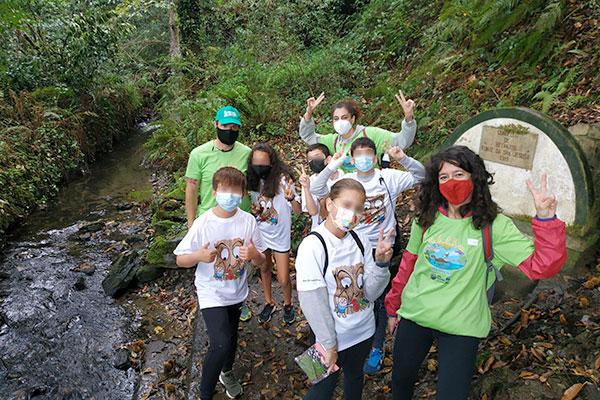Beginning of After-LIFE BACCATA in Galicia: interpretation of monumental yew trees in As Mariñas Coruñesas
20-12-2021

LIFE BACCATA project ended on September 30, 2021, meeting, and even exceeding, the objectives and results expected at the beginning of it. Especially in Galicia the project has implemented an interesting strategy for the restoration of 9580* habitat, extrapolated to the improvement of other natural habitats, especially forest habitat types. All conservation actions have generated valuable knowledge that has been disseminated during the execution of the project, and which will continue to be transferred to other agents and territories after the end of the project, for replication at a EU level. This will be done during After-LIFE BACCATA phase, which will last until September 2026.
The first of After-LIFE BACCATA actions in Galicia has been the celebration of a school workshop with 6th grade students in Sada (A Coruña), in collaboration with the Mariñas-Betanzos Rural Development Association, the entity that manages Mariñas Coruñesas e Terras do Mandeo Biosphere Reserve, as associated beneficiary of LIFE FLUVIAL project (LIFE16 NAT/ES/000771).

The workshop, held at the end of October 2021, has transmitted to schoolchildren the natural and cultural heritage values of the monumental yews that are present in this Biosphere Reserve, among which stands out the Teixo de Baldomir (Bergondo), included in the Galician Catalog of Singular Trees (CGAS the acronym in Spanish), although it is also possible to cite other notable individuals in Pazo de Mariñán (Bergondo) or in Igrexa dos Remedios cemetery (Betanzos), as well as nearby specimens located on A Coruña coast and also included in the CGAS as Teixo dos Tenreiro (Pontedeume) or Teixo de Viladonelle (Neda). The importance of this portion of Coruña coastline in the conservation of monumental yew trees led to the fact that all these were sampled in the genetic analysis of yew populations in Northern Iberian Peninsula that has been carried out during LIFE BACCATA execution..

The event consisted in a visit and identification of yew trees (Taxus baccata), as well as an interpretive route of the cultural (water mills) and natural (riverside forest) heritage that was in the vicinity, thus establishing a valuable synergy between LIFE BACCATA and LIFE FLUVIAL.
The first of After-LIFE BACCATA actions in Galicia has been the celebration of a school workshop with 6th grade students in Sada (A Coruña), in collaboration with the Mariñas-Betanzos Rural Development Association, the entity that manages Mariñas Coruñesas e Terras do Mandeo Biosphere Reserve, as associated beneficiary of LIFE FLUVIAL project (LIFE16 NAT/ES/000771).

The workshop, held at the end of October 2021, has transmitted to schoolchildren the natural and cultural heritage values of the monumental yews that are present in this Biosphere Reserve, among which stands out the Teixo de Baldomir (Bergondo), included in the Galician Catalog of Singular Trees (CGAS the acronym in Spanish), although it is also possible to cite other notable individuals in Pazo de Mariñán (Bergondo) or in Igrexa dos Remedios cemetery (Betanzos), as well as nearby specimens located on A Coruña coast and also included in the CGAS as Teixo dos Tenreiro (Pontedeume) or Teixo de Viladonelle (Neda). The importance of this portion of Coruña coastline in the conservation of monumental yew trees led to the fact that all these were sampled in the genetic analysis of yew populations in Northern Iberian Peninsula that has been carried out during LIFE BACCATA execution..

The event consisted in a visit and identification of yew trees (Taxus baccata), as well as an interpretive route of the cultural (water mills) and natural (riverside forest) heritage that was in the vicinity, thus establishing a valuable synergy between LIFE BACCATA and LIFE FLUVIAL.



